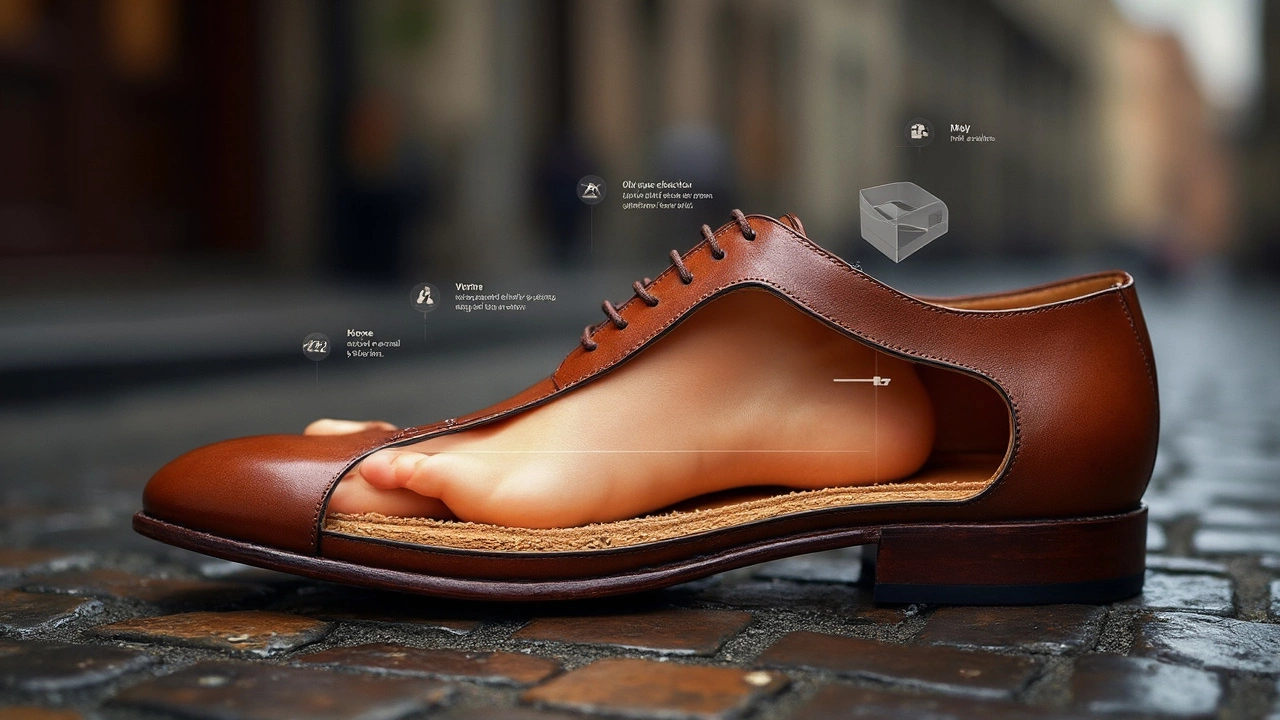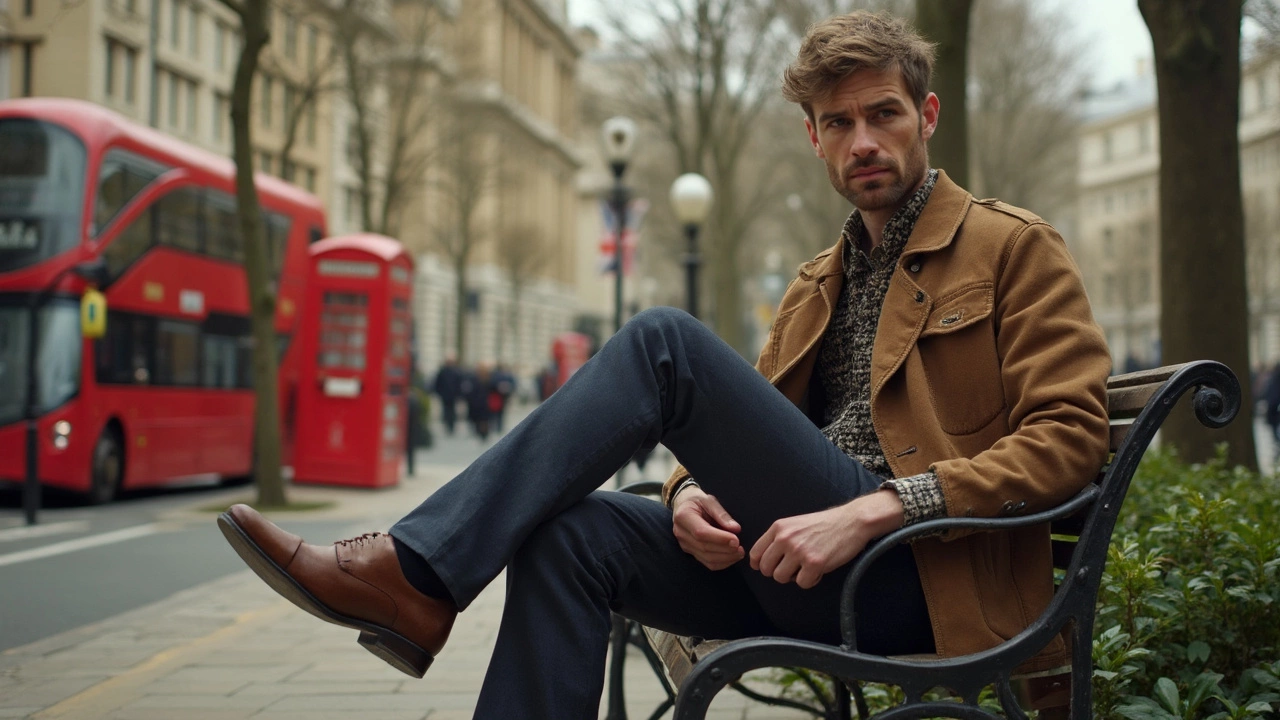Should Your Toes Touch the End of Your Leather Shoes While Walking?

- Cleo Fairchild
- 9 June 2025
- 0 Comments
You slip on a fresh pair of leather shoes, stand up, and instantly wonder—should my toes press right up against the end? It’s one of those questions that never comes with the shoes, but it totally changes how your feet feel all day.
Let’s get straight to it: your toes should not touch the end when you walk. Even a tiny bit of constant pressure can mess with your comfort, squish your toenails, and leave you with blisters if you’re unlucky. A good fit leaves just a bit of breathing room—think a thumb’s width between your longest toe and the shoe’s end (and yes, your longest toe isn’t always your big toe!).
For leather shoes, this rule matters even more. Leather stretches a little, but it’s not a magic fix for shoes that start out too tight. If you’re planning to actually wear your shoes out and about—not just snap a photo—give your toes some space to move with every step.
- Why the Toe-Box Matters
- What Happens When Shoes are Too Short
- How Much Space Do You Really Need?
- Trying Shoes: What to Check
- Leather Shoes vs. Sneakers: A Sizing Trap
- Common Fit Myths and Mistakes
Why the Toe-Box Matters
The toe-box is way more than just extra room at the front of your leather shoes. It’s actually one of the most important parts for comfort, foot health, and even the life of your shoes. The toe-box is the space around your toes inside the shoe, and if it’s not right, nothing else really works.
If the toe-box is too tight or shallow, your feet pay the price. Common issues include blisters, black toenails, corns, and sore spots that make every step feel like a chore. Studies by the American Orthopaedic Foot & Ankle Society have found that about 60% of people wear shoes with toe-boxes that are too small—no wonder so many folks complain about foot pain at the end of the day.
Here’s exactly what a good toe-box should do for you:
- Let your toes spread naturally as you walk (your feet actually get wider when you step down!)
- Prevent stacking and squishing of your toes, especially if you’re on your feet all day
- Keep nails safe from bruising or pressure injuries, which pop up fast when shoes are tight in the toe
- Keep the upper part of your shoe from stretching out too early, so your shoes last longer
There’s real data behind these ideas. Check out this quick chart from a 2023 survey on foot pain and shoe fit:
| Toe-Box Fit | % of People Reporting Pain |
|---|---|
| Too Tight | 68% |
| Just Right | 14% |
| Too Roomy | 28% |
That small bit of space at the end of your shoes is huge for comfort and healthy feet. If you’re ever not sure about the fit, trust what your toes are telling you.
What Happens When Shoes are Too Short
If your leather shoes are too short, your feet will let you know fast. Squeezed toes mean a lot more than just a bit of discomfort at the end of the workday.
Let’s break down what really goes on when you’re stuck in shoes that don’t give your toes enough room:
- Nail Problems: Tight shoes press on your toenails, and that can cause black toenails, bruising, or even make them fall off after a while. People who wear tight dress shoes for long stretches know this pain all too well.
- Blisters and Corns: When your toes keep hitting the front of your shoes, the skin gets irritated. That’s how blisters, calluses, and corns show up—especially around your big and pinky toes.
- Bunions and Hammertoes: Cramming your toes into a tight space for hours can make natural foot defects worse. Bunions get bigger, and your toes can start to curl (hammertoe). Not fun, and it often means surgery if ignored for too long.
- Foot Pain: Short shoes throw off your walking pattern. Every step smashes your toes, messes with your balance, and stresses other parts of your foot. Some even get aches up the ankles and into the knees.
- Shoe Damage: Oddly enough, your shoes get wrecked too. Force from the toes stretches seams and breaks down the front of the shoe much faster.
Just to drive it home, check out how common these problems can get in shoes that don’t fit right:
| Problem | Who Gets It (%) | Notes |
|---|---|---|
| Blisters/Calluses | Up to 75% | Especially common in dress shoe wearers |
| Toenail Damage | Over 50% | Frequently seen in shoes with hard, shallow toe boxes |
| Bunion Worsening | About 30% | Most at risk if there’s a family history |
| Chronic Foot Pain | Almost 40% | Often leads to seeking podiatrist advice |
If you find yourself curling your toes to make them fit, or if you count down the minutes to kick your shoes off, you’re probably a size too small. Long-term, that’s just asking for foot issues you don’t want.
How Much Space Do You Really Need?
So you’re staring down that new pair of leather shoes and wondering, exactly how much room are your toes supposed to have? The answer is more precise than people think. Experts usually recommend about a half-inch gap—that’s roughly the width of your thumb—between your longest toe and the front of the shoe.
This space isn’t just for comfort. When you walk, your feet naturally slide forward a bit with each step. Without that little buffer, your toes end up bumping the front of your shoes all day. That’s why podiatrists look for that thumb-width rule—less than that, and your nails could turn black or your toes might feel numb after a long day.
Here’s how to check if you have the right space:
- Stand up when you try on the shoes—your foot spreads and lengthens when you’re standing.
- Wiggle your toes. Each one should move easily, especially the longest.
- Press down with your thumb at the tip of the shoe while standing. You should feel your toe, but your thumb should fit between your toe and the shoe’s front without cramming.
One cool fact—the longest toe isn’t always your big toe. Loads of people have a second toe that sticks out farther. Always measure for that one, not just the big guy next to it. And don’t depend too much on shoe sizes! Brands measure differently, so what’s a 9 in one style could feel smaller in another. Your feet also tend to swell throughout the day, especially if it’s hot or you’ve been on them for a while. Try on and check new shoes in the afternoon, not first thing in the morning.

Trying Shoes: What to Check
Don’t just grab the first pair that looks great. The whole feel of your leather shoes starts the moment you try them on. Here’s what you need to pay attention to, so you don’t end up regretting your choice after one long walk.
- Toe Room: Stand up in the shoes and wiggle your toes. They shouldn’t hit the front. Check for about a thumb’s width (roughly 1-1.5 cm) of space between your longest toe and the end of the shoe. This gives your feet room when they swell a bit during the day.
- Width Fit: Your foot shouldn’t feel squeezed on the sides. Leather gives a little over time, but shoes that are too tight across the ball of your foot can cause burning, numbness, or bunions.
- Walk Around: Don’t just stand still. Take a walk in the store. Your heel should stay put—if it slips up and down, the shoes are too big or the shape just isn’t right for you.
- Sock Check: Try shoes on with the same kind of socks you’ll actually wear. A thick sock makes a big difference compared to a dress sock or bare feet.
- Bend Test: Stand on tiptoe or squat a bit to see if the shoe creases unnaturally or digs into your foot. Good leather bends; bad fit pinches you right away.
Wondering why the wrong size feels so rough? If your foot slides forward with each step, expect blackened toenails or blisters. On the other side, if the fit is too tight, you risk numb toes or trouble with circulation—neither feels good an hour in.
| Mistake | How to Fix |
|---|---|
| Toes touching the end | Go up half a size |
| Heel slipping | Try a narrower fit or add insole |
| Sides feel tight | Choose a wider size or stretch leather gently |
| Foot slides forward | Use heel grips or check lacing technique |
If you’re shopping online for leather shoes, double-check the store’s return policy. Sizing charts aren’t always spot-on, and brands fit differently. Your best shot is still the old-fashioned try-on session, if you can swing it.
Leather Shoes vs. Sneakers: A Sizing Trap
If you’re used to sneakers, slipping into leather shoes can be a surprise—the fit just feels…odd. Lots of people buy leather shoes in their usual sneaker size, then wonder why their toes are crushed or their heels are slipping. Leather shoes and sneakers are built totally differently, and that throws sizing out of whack.
Most sneakers have a soft, flexible upper with padding, so they can hug your foot closely without hurting. Leather shoes, especially dress shoes, have stiffer materials and a tighter shape. If you buy leather shoes the same length as your running shoes, you might end up with sore toes in places you didn’t expect. Here’s what actually goes on inside:
| Feature | Leather Shoes | Sneakers |
|---|---|---|
| Toe-Box Room | Tighter and more structured | Softer, more forgiving |
| Material Stretch | Minimal (some breaking-in) | Lots (fabric and foam give more) |
| Padding | Usually thin | Thick and comfy |
| Typical Fit | Snug, little give | Cushiony, some flexibility |
This difference sets a trap: buy the size that fits snug in a sneaker, and that same size in leather can squeeze your toes, especially on long walks. Plus, research from the American Orthopaedic Foot & Ankle Society found that nearly 63% of people wear the wrong shoe size, often because brands vary even up to half a size in the same country.
Here’s what you should do instead:
- Always get measured for each shoe type—never assume “my size” is the same everywhere.
- Try leather shoes on late in the day (your feet swell a little by then).
- Walk around the store. If your toes brush the tip or your heel slips, try up or down half a size.
- Know that most leather shoes need a short break-in, but serious discomfort won’t “disappear.”
Don’t trust the number on the box. Go by how the shoes actually feel on your feet, and save your toes a lot of pain.
Common Fit Myths and Mistakes
There are way too many myths about shoe fit that keep people walking around in pain. Let’s bust some of the biggest ones, so your experience with leather shoes is nothing but comfy.
Leather shoes are not supposed to "break in" so much that an uncomfortable pair will magically turn perfect. The break-in stretch is minor—usually less than half a size—so if they pinch badly now, they always will.
Another myth: "Buy snug, they’ll loosen." That’s risky, especially if you wear them often. Leather does mold a bit to your foot, but it won’t stretch enough to add the wiggle room your toes need. If you shop late in the day when your feet are a bit swollen, you’ll usually end up with a fit that works all day, not just in the morning.
Some think the in-store toe test means jamming your toe right up front. Actually, proper fit means you should be able to slide a thumb between your longest toe and the shoe’s end. Kids outgrow shoes—adults just get sore feet if they don’t leave space.
Ever heard that European sizes run narrow? Sometimes true, but not always. Brands vary. That’s why you can’t just depend on the number inside the shoe. Focus on how your foot feels in the shoe—not the size printed on the label.
Here’s some real-world data about shoe fit mistakes that lead to discomfort:
| Issue | Percent Reporting (%) |
|---|---|
| Toes hitting end of shoe | 32 |
| Blisters after short walks | 26 |
| Pain around the ball of foot | 19 |
| Foot cramps in arch or toes | 14 |
It really pays to trust the way your whole foot feels. Here’s what to avoid:
- Thinking the shoe will stretch a whole size—it won’t.
- Letting your heel slip up and down as you walk.
- Ignoring pain on day one, hoping it fades after a few wears.
- Picking shoes by brand or size number alone.
The bottom line: trust what your toes (and the rest of your foot) are telling you. Don’t settle for a fit that feels wrong just because you’re used to the size. Good leather shoes should fit right from the start and stay comfortable.


